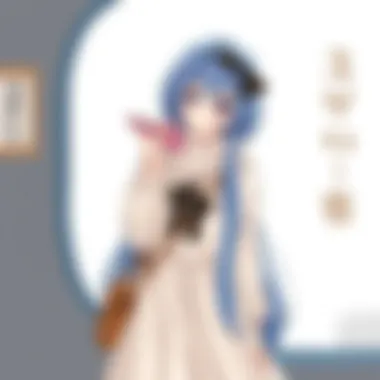In-Depth Look at the Midori Five Year Diary


Intro
Journaling has grown into an art form, evolving through the years from mere handwritten notes to elaborate diaries rich with personal stories and reflections. Among the myriad of options available, the Midori Five Year Diary stands out as a distinctive time capsule designed for thoughtful introspection and daily record-keeping. This tool offers a blend of functionality and aesthetic charm, making it an appealing choice for those who want to document their life journey.
In this comprehensive overview, we will explore the intricacies of the Midori Five Year Diary, diving into its unique features and benefits while shedding light on its cultural relevance in the context of modern journaling. We will tackle common queries regarding its use and how it seamlessly fits into contemporary life, ultimately providing insights that resonate with both casual users and passionate diary keepers.
The charm of the Midori Five Year Diary lies not just in its practicalities; it also reflects deeper themes of memory, nostalgia, and the passage of time. As we embark on this exploration, we aim to present a clear narrative that connects personal experiences with broader cultural contexts, revealing how this journaling tool enriches lives in both subtle and significant ways.
Preface to the Midori Five Year Diary
The Midori Five Year Diary stands as a unique entity in the vast world of journaling, offering both a practical and profound way to document one’s life over an extended period. This form of diary not only serves as a personal record but also allows individuals to engage in self-reflection and creativity. In this article, we’ll shed light on the myriad of features that make the Midori diary a notable choice among both casual writers and ardent journal keepers. Exploring its design and functionality reveals why it has garnered a loyal following.
Historical Context of Diary Keeping
Understanding the Midori Five Year Diary necessitates an appreciation for the rich history of diary keeping itself. Diaries have existed for centuries, evolving from simple records of daily events to complex tools of introspection and expression. Historically, figures like Anaïs Nin and Virginia Woolf have showcased the power of journaling through their personal writings, creating a tradition that intertwines the personal and the public.
The act of keeping a diary is deeply rooted in human culture, serving various purposes. For some, it stands as a record of mundane life; for others, it acts as a refuge, a canvas for thoughts and feelings that might not be shared elsewhere. The Midori Five Year Diary fits neatly into this tradition, allowing users to track their lives day by day, not just in the immediate, but over a span of years. It offers a unique twist: the idea of reflecting on past entries while writing new ones. The cyclical nature of this diary allows users to witness their own growth and changes over time, a reflection that is both fascinating and enlightening.
Overview of the Midori Brand
Midori, a name synonymous with quality stationery, has roots in Japan and is particularly cherished for its attention to detail and functionality. Founded in the early 20th century, the brand has built its reputation on creating products that resonate with both professional and creative types. While many stationery brands offer standard notebooks and planners, Midori takes it a step further by combining traditional craftsmanship with modern design into each product, particularly the Five Year Diary.
The Five Year Diary encompasses not only aesthetic appeal but also practicality. Users can expect high-quality paper that withstands various writing instruments without bleeding or feathering. The sleek design is intended to fit comfortably in hand, making the act of writing enjoyable rather than a chore. Midori successfully captures the essence of journaling - a blend of personal expression and structured format, appealing to all, especially those who appreciate attention to craft and detail in their everyday tools.
"Keeping a diary is a way to observe the passage of time and reflect on the evolution of thoughts, a key reason why the Midori diary has become a cherished companion for many."
Design Features of the Midori Five Year Diary
The Midori Five Year Diary stands out not only for its unique journaling concept but also for its remarkable design features. These elements serve dual purposes: they enhance both the utility of the diary and the overall user experience. Understanding these attributes equips potential users with insights into how to best utilize this diary to meet personal reflections and creativity.
Material and Aesthetics
When it comes to the Midori Five Year Diary, the materials selected speak volumes about its quality and craftsmanship. The cover, often made from high-quality leather or sturdy fabric, exudes a tactile and visual appeal that is hard to overlook. This choice is practical too; it ensures longevity, allowing the diary to withstand the wear and tear of daily usage without losing its character.
The aesthetic presentation of the diary is elegant yet understated, often adorned with subtle textures or colors inspired by nature, which adds to its charm. This simple elegance promotes a calming atmosphere for introspection, making it easier for users to engage with their thoughts. Having a personal artifact that looks pleasing and feels good to the touch can motivate consistent use.
"A diary isn't just paper; it becomes part of your life story."
Moreover, the aesthetic of the Midori Five Year Diary often aligns itself with various art styles found in manga and anime culture, providing a sense of familiarity and comfort for an audience that thrives on visual storytelling. Whether it's a gritty urban landscape or a serene countryside scene, the design resonates deeply with creatives who value both form and function.
Layout and Structure
Moving beyond aesthetics, the layout and structure of the Midori Five Year Diary are thoughtfully designed to accommodate long-term entries. Each page typically features designated sections for each day, spanning five years across a spacious spread. This allows users to capture unique moments, insights, or sentiments in a way that is organized yet flexible enough to encourage brief notes or elaborate reflections.
Such a structure not only simplifies the journaling process but also facilitates a quick glance at previous years' entries. Users often appreciate being able to revisit their past thoughts and feelings, allowing them to see their growth or changes in perspective over time. The design cultivates a sense of continuity, an ever-evolving narrative of one’s life.
The diary often includes additional features like monthly calendars or themed prompts that can guide the user in their writing journey. These prompts provide stimulation for the creatively inclined who may struggle to start their daily entries. The practical consideration of how layout influences the journaling experience is evident here — the diary is not merely a vessel for writing but a tool for self-discovery and growth.
Practical Benefits of Using a Five Year Diary
Using a Five Year Diary like the Midori provides various practical benefits that significantly enhance one's journaling experience. It's not just about jotting down daily events; it’s a mosaic of life, where each piece reflects growth, change, and introspection over time. Here are some specific elements that underscore the importance of these benefits:
Long-term Reflection
Long-term reflection is one of the most powerful aspects of maintaining a Five Year Diary. With the ability to look back on previous entries from the same date in earlier years, users gain a unique perspective on their life’s journey. It's fascinating to see how thoughts, priorities, and emotions can fluctuate, offering invaluable lessons about personal growth. For instance, you might notice how concerns from three years ago have faded or evolved, revealing deeper insights into your character development.
Moreover, this continuous thread can enrich self-awareness. It encourages individuals to take a step back from their busy lives and truly process experiences, thoughts, and feelings.
"A diary is a record of your evolution, a mirror reflecting the person you’ve become over time."
Enhancing Memory and Mindfulness
The act of writing itself is therapeutic and can greatly enhance memory and mindfulness. When you sit down to write in your Midori Five Year Diary, you engage in a form of contemplative practice. Each entry demands attention to detail, promoting mindfulness. You begin to notice small moments that might normally slip past unnoticed—a fleeting smile from a stranger, the taste of a delicious meal, or even the satisfaction of crossing items off your to-do list.
With regular journaling, not only do these memories become more vivid, but they are also preserved. This can serve to strengthen your recall in other areas, enhancing cognitive function by providing a mental workout of sorts. As you practice recalling and articulating your thoughts, you train your brain to hold onto memories more effectively.
Creative Expression
Artistry flourishes in the pages of the Midori. The Five Year Diary not only functions as a record of your life events but also invites creativity. Users can doodle, sketch, and play with layouts, turning each page into a canvas. Integrating illustrations or using colored inks can transform routine writing into an artful expression of emotions and experiences.
This type of creative outlet can be particularly soothing during times of stress or uncertainty. When words fail, a simple illustration can often communicate feelings more powerfully than text. Additionally, it provides a playful way to document life, making everyday entries feel less mundane.


How to Use the Midori Five Year Diary Effectively
Using the Midori Five Year Diary is not just about jotting down daily thoughts or recordings; it’s about integrating this beautiful tool into your life in a way that resonates with your personal goals and feelings. When approached with intention, this diary can serve as a transformative medium for self-reflection and growth. By honing in on effective strategies such as establishing a daily routine, setting achievable goals, and incorporating personal reflections, one can truly maximize the impact of this unique diary format.
Establishing a Daily Routine
Creating a daily routine is crucial when it comes to using the Midori Five Year Diary effectively. A regular practice not only smoothens the path for you to maintain the habit, but also builds a deeper connection between your thoughts and experiences over time. Here are a few steps to help you make it a part of your daily life:
- Pick the Right Time: Find a specific time in your day when you can write without distractions. Whether it’s morning coffee or bedtime reflections, consistency matters.
- Create a Comfortable Space: Designate a space that feels welcoming for writing. Invest in quality pens or markers that inspire creativity. A cozy nook can work wonders.
- Set a Timer: Sometimes, just starting is the hardest part. Setting a timer for a short period—say, 5 to 10 minutes—can help in overcoming that initial inertia. You might find yourself writing longer once you get into it.
Getting used to writing frequently will not only help you fill those pages but also encourage a habit of mindfulness. You might be surprised at how much you can capture in just a few moments each day.
Setting Achievable Goals
Setting specific and achievable goals enhances the journaling experience, providing focus and direction. Without clear targets, it's easy to drift and lose motivation over time. Achievable goals can be as simple as:
- Daily Themes: Designate themes for certain days of the week. For instance, Mondays could be for gratitude lists, while Fridays might be for reflections on the week.
- Monthly Milestones: At the end of each month, review your entries and identify key moments or feelings you’d like to expand on in the following month. This cultivates a sense of progression.
- Track Goals: If you have personal or creative goals, dedicate a section of your diary to tracking them. Reflecting on these can provide motivation and an understanding of your journey.
When you create a structured but flexible plan, it lays down a path. You’ll begin to associate the diary with achieving these personal milestones, making it more valuable to you over the years.
Incorporating Personal Reflections
Incorporating personal reflections into your entries transforms a diary from merely a record of events into a reservoir of thoughts and feelings. Diving deeper beyond surface-level observations enriches your writing tremendously. Here are a few ways to embed personal reflections:
- Ask Yourself Questions: Prompt yourself with questions like “What did I learn today?” or “How did I feel during this experience?” It pushes you to dig a little deeper.
- Use Visual Aids: Sometimes, a picture speaks a thousand words. Consider adding doodles or sketches alongside your entries to encapsulate moments visually.
- Respond to Past Entries: After a few years, it's fascinating to revisit previous entries. You can reflect on how your perspectives have changed. Write down today’s feelings on yesterday’s musings.
Ultimately, personal reflections breed deeper connections with oneself. The Midori Five Year Diary isn't just a tool for recording; it’s a canvas for capturing your life's essence, emotions, and therefore, a key to understanding the evolution of your internal world.
"Keeping a diary is like confiding in a trusted friend; it holds the secrets, memories, and aspirations that shape the journey of life over time."
To sum up, engaging deeply with the Midori Five Year Diary can greatly enrich daily life and personal development. As with any habit, consistency, achievable goals, and meaningful reflections make all the difference, turning simple writing into a powerful means of expression and self-discovery.
Cultural Significance of Journaling
Journaling is not just a personal practice; it carries a rich tapestry of cultural meanings across various societies. The Midori Five Year Diary serves as a focal point for exploring how journaling transcends mere record-keeping, weaving into the very fabric of cultural identity, self-reflection, and expression. This section aims to highlight the multifaceted importance of journaling, particularly in the contexts of Japanese culture and global perspectives.
Journaling in Japanese Culture
In Japan, journaling is not merely a pastime; it is an art form valued for its contribution to personal development and cultural continuity. The concept of “nikki,” or diary writing, has a legacy dating back centuries. It has been integral to literature and self-expression, whether through renowned literary figures like Matsuo Bashō or modern-day students reflecting on their experiences.
The Midori Five Year Diary embodies this cultural reverence. Each page allows users to document their innermost thoughts, feelings, and daily experiences while nurturing a sense of collective memory. Furthermore, this style of journaling emphasizes simplicity and intentionality, encouraging individuals to strip down their thoughts to their essence, which aligns perfectly with Zen philosophies prevalent in Japanese culture.
Journaling in itself acts as a bridge, connecting the individual to the larger narrative of cultural history, allowing personal stories to resonate within the community.
Through the Midori diary, users can engage in the practice of “shikishi,” a traditional format of recording sentiments on decorative paper that evokes beauty. Keeping a diary in Japan is often about maintaining aesthetic quality in writing, where the physicality of the journal enhances the act of writing, turning it into an experience rather than a chore.
Global Perspectives on Diary Keeping
Outside of Japan, the act of journaling embraces diverse cultural meanings and practices. From the reflective accounts found in Western literature to the expressive slam poetry movements in urban areas, journaling is a spectrum of voices. For instance, diary keeping has been pivotal for historical figures such as Anne Frank and Virginia Woolf, whose writings capture deeply personal experiences while also addressing broader societal issues.
Countries across the globe have their unique takes on what journaling means. In some cultures, diaries serve as tools for tracking agricultural cycles or family histories, while others might use them as therapy for mental health. In the digital age, journaling has expanded beyond physical pages; platforms like Reddit and dedicated apps have made self-expression accessible, encouraging new generations to engage with their thoughts and feelings.
Moreover, incorporating different formats, from bullet journaling to art journaling, reflects the global blend of cultural influences and personal preferences. As people navigate their specific circumstances through the lens of their diaries, they contribute to a universal narrative of human experience, fostering connections with others across the world.
In essence, journaling is a profound testament to individuality and collective identity, intertwining personal milestones with cultural narratives, as seen in practices around the Midori Five Year Diary.
Common Misconceptions about Journaling
Journaling carries a weight of assumptions that often deter individuals from delving into its depths. These misconceptions can cloud the mind, making drawing forth a pen feel like a Herculean task instead of a simple practice. Understanding these myths is vital, as dispelling them can transform how we perceive and engage in journaling. The Midori Five Year Diary, with its thoughtful design and user-centric approach, serves as an ideal tool to debunk these myths and uncover the beauty of self-reflection.
The Myth of Perfect Entries
One prevalent misconception is that journaling demands perfection. Many believe that every entry must be a masterpiece, eloquently articulated and brimming with profound insights. This mindset can create a mental block, akin to staring at a blank canvas with the weight of expectation hanging overhead. However, the true beauty of journaling lies in its authenticity.
The Midori Five Year Diary invites you to embrace the ordinary. The layout is forgiving; its structure encourages short entries, allowing for everyday musings to be just as valid as grand revelations. Consider these points:
- Authenticity Over Aesthetics: Your diary should reflect your thoughts, not a polished version of them.
- Everyday Moments Matter: Note down the mundane—like what you had for breakfast or a fleeting thought—that can spark joy when revisiting.
- Progress Over Perfection: There’s a learning curve to writing. The more you write, the better you become at expressing yourself.
"A journey of a thousand words begins with a single scribble."
Assumptions about Time Commitment
Another common fallacy is the belief that journaling requires extensive time commitment. Some assume they need a dedicated hour each day to craft elaborate entries, which can sound daunting. This notion might make potential journalers shy away from the practice altogether.


In reality, time spent journaling is flexible and can easily fit into a busy schedule. Here’s how the Midori Five Year Diary accommodates different lifestyles:
- Short Drops Can Be Enough: Even a few minutes can lead to meaningful reflections. A simple sentence or a single thought can capture an entire day’s essence.
- Flexible Schedule: You don’t have to adhere to a rigid timeline. Journal entries can be made at your convenience—maybe during a coffee break or while waiting for the bus.
- Mix and Match: Just like a playlist, you can vary your entries—some days might call for detailed reflections while others could merit simple one-liners.
By shifting from a view of journaling as a time-consuming obligation to seeing it as a fluid and adaptable practice, you open doors to a world of reflection that you can engage with as often or as little as desired. Embracing these realities allows for personal growth and self-discovery, making the experience of using the Midori Five Year Diary fulfilling.
Maintaining Motivation for Long-Term Journaling
Maintaining motivation for long-term journaling is not just about putting pen to paper; it’s more akin to nurturing a relationship. Over time, one must adapt, reinvent, and even revive the spark that originally ignited the journaling journey. The Midori Five Year Diary stands out here, as its unique design invites users to engage with their thoughts on a daily basis, making it easier to sustain this essential habit. When you incorporate such a tool into daily life, it serves as a reminder of personal growth and an opportunity for deep reflection.
Tracking progress and milestones can serve as a significant motivator in the world of journaling. It's a visual reminder of your journey, a concrete representation of how much you've experienced over time. When flipping through the pages, there's a palpable sense of achievement in seeing the accumulation of thoughts, dreams, and milestones.
You might start by setting specific, measurable goals in your diary, such as daily writing or completing a monthly reflection. This becomes a road map for your journey. Rather than viewing it as a daunting task, think of it as a platform for exploration. By marking significant events or feelings, readers can actively trace their development like a map illustrating the terrain of their lives.
Moreover, logging these milestones doesn’t have to be a burdensome task. You can sprinkle in achievements or even low-key events that brought you joy. A successful week at work, a nice conversation with a friend, or even a simple recipe tried. All these moments matter. They build a story that you look forward to reading in retrospect.
- Milestones could include:
- Birthdays or anniversaries
- Career achievements
- Personal realizations
- Travel experiences
Using the Midori Five Year Diary in this context helps to create layers of meaning that enrich your recollections.
Creating a reward system can add a layer of excitement and accountability to your journaling habit. Who says only kids get to enjoy rewards? Designing a system that acknowledges your commitment can invigorate your relationship with the diary. For example, after a successful month of journaling, treat yourself to something special. It could be as simple as a new pen or an outing with friends. Rewarding yourself fosters a positive feedback loop that reinforces the habit.
Just think of it this way: every time you fill in a page, you're investing in your personal growth. And with that investment, a little appreciation goes a long way. In developing your reward system, here are a few ideas to keep in mind:
- Goals-Based Rewards: Set a number of entries and treat yourself for completion.
- Completion Treats: After reaching the end of a year or a milestone, allow yourself a gift, large or small.
- Social Rewards: Share some insights from your diary with friends or online communities, acknowledging the journey together.
Ultimately, maintaining motivation is about cultivating a routine that works for you, guiding your hand as it glides across those pages, pouring your heart out. With the right techniques, to keep that fire burning, the Midori Five Year Diary transforms from mere paper into a vault of memories, a sanctuary for thoughts that evolves just as you do.
Comparison with Other Journaling Methods
The world of journaling is vast, offering a variety of methods for individuals seeking to document their life experiences. Each of these methods presents unique attributes that can meet the diverse needs of everyday users. When considering how the Midori Five Year Diary fits into this broader landscape, it is essential to look closely at distinct journaling modalities available today, predominantly focusing on digital journals, physical journals, and the specific framework of the five-year concept compared to other formats.
Digital Journals vs. Physical Journals
In recent years, the rise of technology has ushered in a new era for journaling, moving many enthusiasts towards digital platforms. Apps like Day One or Journey provide options for users to jot down entries with ease, often utilizing the convenience of cloud storage. This feature allows for seamless integration across devices. However, there lies a fundamental difference in tactile experience and engagement that physical journals, like the Midori Five Year Diary, offer.
Benefits of Digital Journals:
- Accessibility: Digital entries can be made anytime, anywhere, as long as you have your device.
- Multimedia: Users can easily include photos, videos, and links, enriching their narratives.
- Organization: Easy search functions help to find entries quickly.
Benefits of Physical Journals:
- Tangibility: The act of writing by hand fosters a deeper connection to thoughts and emotions. Users often find this practice to be more meditative.
- Aesthetic Experience: Physical diaries often incorporate beautiful designs and layouts, enhancing the joy of writing. The Midori Five Year Diary is a prime example, with its elegant craftsmanship.
- Personalization: Physical journals allow for doodles, drawings, stickers, and more, making each page a unique expression of the writer.
A significant factor is the user’s personal preference. Some might prioritize convenience and multi-faceted experiences offered by digital formats, while others lean towards the emotional satisfaction invoked by pen on paper.
The Five Year Concept vs. Other Formats
The five-year format presents a distinctive approach to journaling. Unlike traditional methods that may consist of daily entries or themed journals focusing on specific topics, the Midori Five Year Diary allows users to reflect on their growth over an extended timeline. This pace can foster deeper insights about one's life and experiences.
Comparison with Other Formats:
- Daily Journals: In contrast to a daily diary where every day requires a new entry, the five-year concept encourages summarizing thoughts or events in just a few lines for each day. This aids in reducing pressure while still retaining meaningful reflections.
- Bullet Journals: These journals focus on organization and productivity, often including to-do lists or habit trackers. While beneficial for planning, they may lack the emotional depth that personal narratives provide, which the Midori offers over time.
- Gratitude Journals: Typically centered around positivity, gratitude journals may limit the scope of reflection. The five-year diary opens opportunities for users to explore setbacks and victories alike, presenting a fuller picture of personal evolution.
"A five-year diary invites you to take the long view of your life, encouraging a profound understanding of your journey."
Ultimately, the choice between these approaches boils down to what someone wishes to achieve. If the goal is to record daily life in real-time, a daily journal may suit best. However, if one aims for concerted reflection over time, the Midori Five Year Diary’s structure naturally aligns with that desire.
In summary, while both digital and physical journaling formats have their respective merits, the Midori Five Year Diary’s unique approach declares its ongoing relevance in the diverse spectrum of journaling methods. Its design and function can attract both tech-savvy individuals and traditional journal writers, allowing a space for introspective growth over several years.
Personal Stories: Experiences with the Midori Diary
Personal experiences with the Midori Five Year Diary often reveal its profound impact beyond mere record-keeping. At its core, this diary serves not only as a repository for thoughts but also as a canvas for self-exploration. Users from various walks of life share a common thread: the diary is a faithful companion through the ebb and flow of daily existence.
One notable aspect of the Midori diary is how it offers a chance for reflection that can sometimes get lost in the hustle and bustle of modern life. Individuals frequently leverage the structure of this diary to chart their emotional landscapes over the years. Many find comfort in looking back on their entries, noticing patterns, and recognizing personal growth.
In a culture where instant communication often overshadows deeper forms of introspection, the Midori Five Year Diary fosters a space that invites users to pause and consider their journey. It encourages a habit of reflection that enriches one’s understanding of personal experiences and effects lasting insights.
Testimonials from Users


Several users of the Midori Five Year Diary have shared heartfelt testimonials about its influence on their lives. For example, one user recounted how documenting daily highlights improved her appreciation for the seemingly mundane aspects of life. "Writing about even the smallest joys, like sipping tea on a rainy afternoon, made me see my days differently," she noted. This perspective shift fostered gratitude and increased her overall happiness.
Another user highlighted how, during life transitions, the diary became an essential tool for emotional processing. After moving to a new city, he used the diary to capture his feelings of uncertainty and excitement. By reflecting on these entries, he later acknowledged how much he had grown in adapting to his new environment.
“It’s not just a diary; it feels like a mirror reflecting my journey,” one user stated, illustrating how deeply the Midori diary resonates with those who engage with it.
Expressive Journeys Captured
The true beauty of the Midori Five Year Diary lies in its ability to encapsulate unique, personal narratives. Users often delight in recording their expressive journeys, integrating sketches, poems, and thoughts that narrate their lives over five years. For many, this diary has become a visual and written tapestry of their evolution.
Notably, there’s a therapeutic element to this expressive documentation. Some individuals utilize art as a cathartic means to address complex emotions. Whether through whimsical doodles in the margins or sentimental drawings accompanying poignant entries, these personalized touches enhance the experience of journaling. It’s almost like creating a visual diary that interweaves both words and images, offering a richer look at one's journey.
Maintaining the Midori Diary over the years allows users to witness how their aspirations and fears change. New entries can reveal unexpected shifts in priorities or highlight significant milestones—like capturing the initial excitement of a budding relationship or reflecting on a personal triumph following hardship. This capacity to convey an evolving self—rich in depth and detail—underscores the integral role of journaling in personal growth and understanding.
Integrating the Diary into Daily Life
Integrating the Midori Five Year Diary into one’s daily routine is not just about writing; it’s about creating a sanctuary for reflective thought and personal growth. This diary can serve as a bridge between the chaotic pace of life and the calm introspection that journaling fosters. Considered a tool for crafting connections to one’s thoughts and emotions, this diary transforms daily happenings into lasting memories.
Making Space for Reflection
Establishing a physical and mental space for reflection is vital in making the most of the Midori Five Year Diary. Life, often hectic, makes it easy to overlook moments that deserve recall. By dedicating a corner of your home or workspace solely for this diary, you signal to yourself the importance of pausing and reflecting.
- Create a Comfortable Environment: Think about lighting, seating, and the ambiance that encourages you to sit down and write. Perhaps a cozy chair by the window or a spot on the porch?
- Set a Regular Time: Whether it’s early morning with a cup of tea or late night as a wind-down, consistency breeds habit. Just like brushing your teeth or taking a shower, make it a ritual that you anticipate.
- Eliminate Distractions: Put away your phone and close your laptop. Create a distraction-free zone where the only focus is you, your thoughts, and your diary. Notifying others that this is your quiet time helps maintain that peace.
Carving out this space transforms writing from a chore into an anticipated retreat. You may find that jotting down your thoughts becomes as integral as other daily activities like eating or exercising.
Sharing Insights with Others
After investing time in self-reflection, what’s the harm in sharing those insights? Some entries may be too personal to share, but many can spark meaningful conversations. Here’s why this sharing matters:
- Building Connections: When you share your experiences or thoughts from your diary with others, you may find common ground or support, infectious curiosity encouraged by vulnerability. It often opens avenues for discussing deeper issues and ideas.
- Cultivating a Community: Consider joining a journaling group or an online forum where people discuss their journeys. Platforms like Reddit or Facebook have groups specifically for diary enthusiasts. Sharing your reflections can inspire others, and theirs can add depth and breadth to your own understanding.
- Feedback for Growth: Sometimes, outside perspectives can offer refreshing takes on your thoughts. Feedback, whether welcomed or not, can act as a mirror reflecting back your insights and encouraging growth.
Ultimately, integrating the Midori Five Year Diary into your daily life is about more than just keeping track of days or thoughts. It encourages an evolving dialogue with yourself, transforming mundane events into profound reflections. This leads to a richer, more connected life—a tapestry of memories woven over five years, each page a step on the path to mindfulness and self-discovery.
The Role of Art in Journaling
Art has always held a unique place in the realm of journaling, particularly with tools like the Midori Five Year Diary. The integration of artistic expression into the journaling process not only enriches the narrative but also allows for a deeper exploration of one’s thoughts and emotions. In this section, we will delve into the significance of art in this journaling method, focusing on how it transforms ordinary entries into extraordinary reflections.
Incorporating Illustrations
When one thinks of a traditional diary, they might picture neatly lined pages filled with notes or daily summaries. However, the Midori Five Year Diary encourages a different approach that includes illustrations. By doodling, sketching, or even printing images, users can create a visual representation of their experiences. This aspect of journaling offers several benefits:
- Enhanced Engagement: Illustrating thoughts or feelings can significantly heighten engagement with the diary, as it becomes not just a writing tool but also a canvas for self-expression.
- Memory Aids: Visuals often leave a more lasting impression. When one draws a picture about a memorable day, it’s likely to evoke memories more vividly than text alone.
- Therapeutic Outlets: Art can serve as an emotional release. Drawing or coloring can reduce stress and anxiety, making the journaling practice a cathartic experience.
For many users, the act of incorporating illustrations creates a more satisfying and multidimensional diary entry, offering a welcome break from text-heavy pages. It's not merely about artistry, it's about embedding feelings and memories in a format that is personally meaningful.
Visual Storytelling Techniques
Visual storytelling is a powerful tool that can elevate the journaling experience. Utilizing various techniques for storytelling can help users communicate their narratives in ways that pure text cannot. Here are a couple of techniques applicable to the Midori Five Year Diary:
- Color-Coding: Assigning specific colors to emotions can create a visual mood ring on the pages. For example, blue might represent melancholy while yellow signifies joy. This can aid in recognizing patterns in one's mental health over time.
- Collage Creation: By combining images, snippets from magazines, or even ticket stubs with personal notes, one can craft a collage that tells a story beyond words. This multi-layered approach offers broader insights into experiences and can bring excitement to routine entries.
"A picture is worth a thousand words." In journaling, visual storytelling can add depth that words sometimes struggle to capture.
Art in journaling, particularly with a tool like the Midori Five Year Diary, is far more than a decorative addition; it serves as a vital aspect of the self-reflective process. Combining visual and written elements creates a richer tapestry of life experiences. Users, especially those inclined towards anime and manga, will find an avenue to merge their artistic passions with their journaling practices.
In this way, the Midori Five Year Diary promotes not just the capturing of moments but also the celebration of creativity, making journaling a vibrant part of everyday life.
Ending: The Enduring Value of the Midori Five Year Diary
The Midori Five Year Diary stands as a remarkable tool for personal reflection and growth, bridging the gap between mere recording of events and deep, meaningful exploration of one's life. This diary not only signifies a commitment to long-term journaling but also weighs heavily on the importance of reflection within a fast-paced world. In today’s era, where fleeting thoughts scatter like leaves caught in the wind, having a physical space to anchor these moments can be both grounding and enlightening.
Summarizing Key Insights
Throughout this exploration, several key insights about the Midori Five Year Diary become apparent:
- Multi-Year Perspective: The concept of a five-year layout offers a unique vantage point. Users can revisit their past entries, creating a fascinating dialogue between their past selves and present realities, allowing for personal growth and understanding.
- Aesthetic Appeal: The Midori diary is not just a functional item; its beautiful design invites users to engage with it. From the luxurious cover to the quality of the paper, each aspect is crafted to enhance the writing experience.
- Encouragement of Consistency: By dedicating a small amount of time each day, individuals cultivate a habit that fosters mindfulness and reflection. This visual representation of daily entries serves as motivation to maintain that practice.
"Journaling with the Midori gives me the ability to map out not just events, but my feelings and thoughts over the years. It’s like having a conversation with my former self."
— Anonymous User
This diary encapsulates a journey rather than just a simple record, and it reflects more than just the events but the evolution of thoughts and feelings that come with them.
Encouraging a Lifelong Habit
Embracing a habit of journaling with the Midori Five Year Diary can be transformative, nurturing not just personal growth but also enhancing clarity in an often chaotic life. To further cultivate this lifelong habit, consider the following:
- Consistency Over Quantity: Prioritizing small, regular entries can be more beneficial than occasional longer entries. Just a few lines a day is enough to maintain the practice.
- Set Realistic Expectations: There’s no need for perfection in entries. Allowing oneself to write freely can liberate the process and reduce pressure.
- Connect with Community: Engaging with fellow enthusiasts on platforms like Reddit can provide inspiration and motivation. Sharing experiences and insights can reignite passion for journaling.
In summary, the Midori Five Year Diary represents more than a simple collection of thoughts—it's a vessel for chronicling one's journey through life, fostering a habit that can last a lifetime. Encouraging users to embrace this art of reflection, it holds immense value in a world that often overlooks the richness of daily life.







